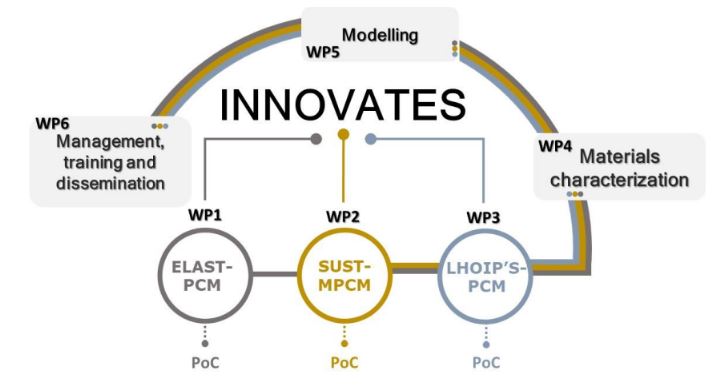INNOVATES: : Innovative Design of Phase Change Materials for Advancing Thermal Energy Storage Solution
PID2024-159867OB-I00 – MINISTERIO DE CIENCIA E INNOVACIÓN, Gobierno de España

Adopting renewable energy sources (RESs) faces challenges like intermittency, low load capacity, and non-dispatchability, making energy storage crucial for RES deployment. Energy storage systems (ESSs) ensure renewable energy sustainability and balance supply and demand. ESSs, categorized by the energy form they store, offer diverse solutions. Thermal energy storage (TES) systems store thermal energy from sources like solar, geothermal, and industrial waste heat, used in power generation, water heating, building thermal comfort, and battery thermal management (BTM). A well-designed TES system minimizes non-renewable resource use and improves energy efficiency. TES systems respond dynamically to local conditions, offering high energy densities and buffering indoor thermal fluctuations. Key TES attributes include capacity, charge/discharge rates, efficiency, storage duration,
response time, and cost, determining their effectiveness for various needs. Therefore, a material-based design of TES systems is essential. Latent Heat Storage (LHS) systems use thermal energy to induce phase changes (S-S, S-L, or L-S) in materials, absorbing or releasing heat at nearly constant
temperatures. LHS systems achieve higher energy storage density than sensible heat storage. In buildings specifically, phase
change materials (PCMs) are valuable for achieving energy consumption reduction. These materials can be integrated into either a passive system (e.g., building envelopes) or an active system (e.g., on-siteinstallations). To ensure a sustainable reduction in the environmental impact of heating, ventilation, and air conditioning (HVAC) systems, TES solutions must be technically feasible and economically viable.
TES systems offer advantages in terms of both economic efficiency and reduced environmental impact. To prevent leakage during the melting process, PCMs must be encapsulated before being incorporated into the final system. Microencapsulated phase change materials (MPCMs), embedded in passive building systems have shown potential for reducing peak energy demands, associated with heatingand cooling systems.
With INNOVATES, the aim is to contribute to the development of thermal energy storage technology
by developing new phase material solutions that facilitate their integration into energy systems
PARTNERS

More information: Prof. A. Inés Fernández; Dr. Jessica Giró